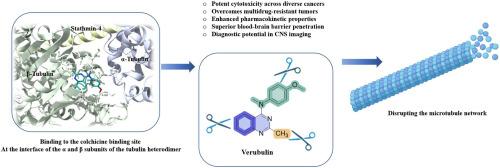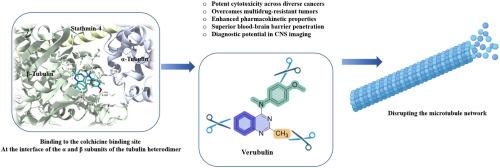Verubulin and its derivatives: Progress and promise in tubulin-targeted cancer therapy
IF 5.9
2区 医学
Q1 CHEMISTRY, MEDICINAL
引用次数: 0
Abstract
Verubulin (MPC-6827) is a microtubule-destabilizing agent that binds to the colchicine site of tubulin and has been primarily investigated for the treatment of glioblastoma and other malignancies. Its ability to interfere with microtubule dynamics, induce mitotic arrest, and retain efficacy in multidrug-resistant tumour cells has positioned it as a valuable scaffold in the development of next-generation anticancer agents. Over the past decade, extensive efforts have been dedicated to optimizing verubulin and its derivatives through modifications that enhance potency and selectivity. Additional strategies have aimed to improve metabolic stability and brain penetration to expand their therapeutic window and clinical utility. In addition to its therapeutic applications, the small molecular size and high affinity of verubulin for tubulin have also enabled its exploration as a molecular imaging agent in brain-targeted diagnostic research. This review provides a comprehensive overview of the pharmacological profile, clinical development, and structural evolution of verubulin-based compounds, emphasizing their role in advancing tubulin-targeting strategies in oncology. It also offers a future perspective on the potential of verubulin derivatives and the prospects for new candidates to enter clinical evaluation.


微管蛋白及其衍生物:微管蛋白靶向癌症治疗的进展和前景
Verubulin (MPC-6827)是一种微管不稳定剂,与微管蛋白的秋水仙碱位点结合,主要用于治疗胶质母细胞瘤和其他恶性肿瘤。它能够干扰微管动力学,诱导有丝分裂停止,并在多药耐药肿瘤细胞中保持功效,这使其成为开发下一代抗癌药物的有价值的支架。在过去的十年中,广泛的努力已经致力于优化马鞭草素及其衍生物通过修饰,提高效力和选择性。其他策略旨在改善代谢稳定性和脑渗透,以扩大其治疗窗口和临床应用。除了它的治疗应用,小分子尺寸和高亲和力的微管蛋白也使其探索作为分子显像剂在脑靶向诊断研究。本文综述了基于微管蛋白的化合物的药理学概况、临床发展和结构演变,强调了它们在推进肿瘤微管蛋白靶向策略中的作用。它还提供了未来的前景,对潜力的维鲁球蛋白衍生物和前景的新候选人进入临床评价。
本文章由计算机程序翻译,如有差异,请以英文原文为准。
求助全文
约1分钟内获得全文
求助全文
来源期刊
CiteScore
11.70
自引率
9.00%
发文量
863
审稿时长
29 days
期刊介绍:
The European Journal of Medicinal Chemistry is a global journal that publishes studies on all aspects of medicinal chemistry. It provides a medium for publication of original papers and also welcomes critical review papers.
A typical paper would report on the organic synthesis, characterization and pharmacological evaluation of compounds. Other topics of interest are drug design, QSAR, molecular modeling, drug-receptor interactions, molecular aspects of drug metabolism, prodrug synthesis and drug targeting. The journal expects manuscripts to present the rational for a study, provide insight into the design of compounds or understanding of mechanism, or clarify the targets.

 求助内容:
求助内容: 应助结果提醒方式:
应助结果提醒方式:


